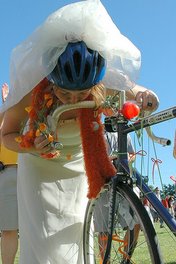Nicaragua: El Cua, La Pita, Bocay
30 junio 2007: El Cua, La Pita, Bocay
had breakfast at the same spot in El Cua. tortillas and ¨queso seco¨. funky cheese, as Anna calls it. we met with Inocencio, or Ël Mexicano¨(called this because he spent 12 years in Mexico), who drove us in ATDER´s 4x4. we headed for La Pita, one of the micro-hydro plants. El Mexicano works in the taller, or machine shop, of ATDER-BL. they have a few lathes, a few drill pressesand the obligatory tabgle saw among other tools. their shop is often used to make pieces for the turbines, etc. that are easier and cheaper to make than they would be to hunt down and buy.
when we got to La Pita, El Mexicano showed that a few parts he had created were at work in the La Pita turbine. i wondered what he did while in Mexico and later learned from Anna that he worked as a taxi driver.
a number of folks were kind enough to greet us in La Pita - Dionysio, who was sporting a CARE tshirt, Euclides, whose jacket had Ben Linder´s logo on it, Isidoro and Lionel. 
we went next to the co'op, a place where bananas are treated and washed so that they will fetch a higher price on the market. it{s a cooperative with over 30 people. we went around the area a little more and checked out the welding area, complete with rusted trucks and junkyard dogs. on the way back, there was a family of four women. when asked how the light had changed them, they said simply, ¨we have light. our house is beautiful now¨. they seemed happy at being called guapas. the adjective or my bad spanish? you decide.
next was a meeting with everyone involved with the plant back at the telephone office. there was a cinematographer with cameras draped like leaves awaiting us from ASOLPIC hat made us feel better, what with our cameras. i will assume Anna can describe the meeting better than me. El Mexicano and i went back to check out the school which was closed. it is a primary school. the secondary school students go to El Cua. El Mexicano said he came back from Mexico 4 years ago and started wrking for ATDER shortly after that. before, he was working as a taxi driver in Mexico City, which is not nearly so beautiful as La Pita. not hard to imagine.
going back to the meeting, the fellow from ASOLPIC asked everyone to say what they thought of GE. he first just asked Anna and i our impressions of La Pita. the most important questions asked of any of the three women present seemed to be ¨soltera o casada?¨ this pretty well sent us on our way to Bocay.
on the way t Bocay, we stopped by the lechadura, complete with its own generator. the lechadura keeps the milk cold, about 45 degrees when we visited.
Bocay{s generator does not currently have the second injector installed, which will augment both the number of people and the wattage. i believe the main issue is just one of connecting. it was amazing to see the amount of water that could generate s much energy.
in Bocay, there s a new school named after Elisabeth Linder. when we were there, there was a computer course in sesion teaching basics of spreadsheets. Ella, the office manager for the school, said that students who learn will use new skills for further study but will most likely stay in Bocay.
Chepito, manager of APRODELBO, was pretty darn forthcoming on a lot of issues. one of the most interestingaspects of the conversation was corporate social responsibility. let{s just say he wasn{t a fan.
we went to dinner and discussed different types of music. everyone seemed to like ranchero, no one understood the abiding love that Anna and i have for reggaetown. the restaurant was open after dark with at least 2 refregerators. whole trucks were in town for saturday evening religious services. Felix was right: the music and lights seemed to make everything festive. walked back after dark, we noticed most houses were still lit with music and talking coming from within. we walked under at least three lights.



No comments:
Post a Comment